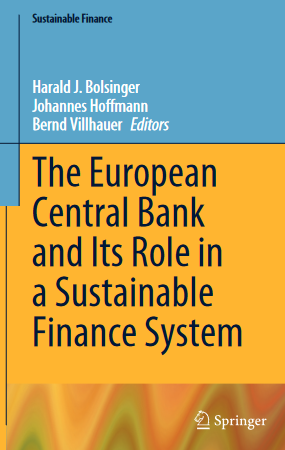transitions to carbon-neutral economies are possible and necessary. They are also cheaper for everyone, including banks and industry. To understand the role of the ECB in creating a sustainable financial system, we have to look at the financial activities of the ECB itself, monetary policy, communication and interaction with banks, and administrative actions on different levels. Fortu- nately, there are European frameworks and institutions on which the ECB activities and initiatives can be based. 1 The Role of the ECB in the Climate Crisis Sustainability is understood broadly in the financial world, very often under the term stability. For example, a sustainable financial system needs rules; it needs sustain- able public finances; it needs price stability. The issue of climate or comprehensive environmental sustainability plays an important role for central banks because it can shake the pillars of a sound financial system and at the very least challenge the standard economic models, thus permanently calling financial stability into question. Environmental sustainability, however, is still a fairly new topic for central banks. The “Network for Greening the Financial System” (NGFS) was only founded in 2017, at that time by eight central banks; by 2022, 108 central banks are already members. Incidentally, the founding chairman was Frank Elderson, who has been on the ECB Executive Board since the end of 2020. The very fact that central banks are addressing the climate issue at all is politically controversial. Perhaps somewhat less frequently than a year or two ago, there are still comments from experts and journalists who think we are exceeding our mandate by doing so. On the other side, there are civil society organizations that think the ECB is not doing enough or is even supporting activities that are harmful to the climate
چکیده فارسی
انتقال به اقتصادهای کربن خنثی ممکن و ضروری است. آنها همچنین برای همه از جمله بانک ها و صنعت ارزان تر هستند. برای درک نقش بانک مرکزی اروپا در ایجاد یک سیستم مالی پایدار، باید به فعالیتهای مالی خود بانک مرکزی اروپا، سیاستهای پولی، ارتباطات و تعامل با بانکها و اقدامات اداری در سطوح مختلف نگاه کنیم. خوشبختانه، چارچوبها و نهادهای اروپایی وجود دارد که فعالیتها و ابتکارات بانک مرکزی اروپا میتواند بر آنها مبتنی باشد. 1 نقش بانک مرکزی اروپا در بحران آب و هوایی پایداری به طور گسترده در دنیای مالی درک می شود، اغلب تحت عنوان ثبات. به عنوان مثال، یک سیستم مالی پایدار نیاز به قوانین دارد. به منابع مالی عمومی پایدار نیاز دارد. به ثبات قیمت نیاز دارد. موضوع اقلیم یا پایداری زیست محیطی جامع نقش مهمی را برای بانکهای مرکزی بازی میکند، زیرا میتواند ستونهای یک سیستم مالی سالم را متزلزل کند و حداقل مدلهای استاندارد اقتصادی را به چالش بکشد، بنابراین ثبات مالی را برای همیشه زیر سوال میبرد. با این حال، پایداری زیستمحیطی هنوز یک موضوع نسبتاً جدید برای بانکهای مرکزی است. «شبکه سبز کردن سیستم مالی» (NGFS) تنها در سال 2017 و در آن زمان توسط هشت بانک مرکزی تأسیس شد. تا سال 2022، 108 بانک مرکزی در حال حاضر عضو شده اند. اتفاقاً، رئیس موسس فرانک الدرسون بود که از پایان سال 2020 در هیئت اجرایی بانک مرکزی اروپا حضور داشت. این واقعیت که بانک های مرکزی اصلاً به موضوع آب و هوا رسیدگی می کنند، از نظر سیاسی بحث برانگیز است. شاید کمتر از یک یا دو سال پیش، هنوز نظراتی از سوی کارشناسان و روزنامه نگاران وجود دارد که فکر می کنند ما با انجام این کار از وظایف خود فراتر می رویم. از سوی دیگر، سازمانهای جامعه مدنی وجود دارند که فکر میکنند بانک مرکزی اروپا به اندازه کافی انجام نمیدهد یا حتی از فعالیتهایی حمایت میکند که برای آب و هوا مضر است
ادامه ...
بستن ...
Editors
Harald J. Bolsinger
Technical University of Applied Sciences
Würzburg-Schweinfurt (THWS)
Würzburg, Germany
Johannes Hoffmann
Goethe University Frankfurt
Frankfurt, Germany
Bernd Villhauer
Weltethos-Institut
Tübingen, Baden-Württemberg, Germany
ISSN 2522-8285 ISSN 2522-8293 (electronic)
Sustainable Finance
ISBN 978-3-031-24477-3 ISBN 978-3-031-24478-0 (eBook)
https://doi.org/10.1007/978-3-031-24478-0
© The Editor(s) (if applicable) and The Author(s), under exclusive license to Springer Nature Switzerland
AG 2023
This work is subject to copyright. All rights are solely and exclusively licensed by the Publisher, whether
the whole or part of the material is concerned, specifically the rights of translation, reprinting, reuse of
illustrations, recitation, broadcasting, reproduction on microfilms or in any other physical way, and
transmission or information storage and retrieval, electronic adaptation, computer software, or by
similar or dissimilar methodology now known or hereafter developed.
The use of general descriptive names, registered names, trademarks, service marks, etc. in this publication
does not imply, even in the absence of a specific statement, that such names are exempt from the relevant
protective laws and regulations and therefore free for general use.
The publisher, the authors, and the editors are safe to assume that the advice and information in this
book are believed to be true and accurate at the date of publication. Neither the publisher nor the authors or
the editors give a warranty, expressed or implied, with respect to the material contained herein or for any
errors or omissions that may have been made. The publisher remains neutral with regard to jurisdictional
claims in published maps and institutional affiliations.
This Springer imprint is published by the registered company Springer Nature Switzerland AG
The registered company address is: Gewerbestrasse 11, 6330 Cham, Switzerland
ادامه ...
بستن ...










